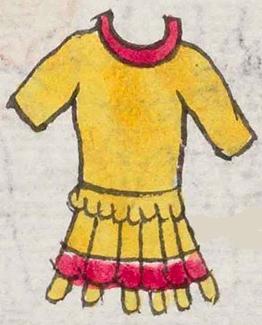cozotl (Mdz13r)
This simplex glyph has multiple components, and yet they are all fused. It can stand for the place name, Cozohuipilecan, or the word for the garment called a huipilli, or the word for a yellow parrot (or its feathers), cozotl). It is a garment with a long-sleeved top and a feathered skirt, primarily yellow, but with a red accent around the next, and a red horizontal stripe across the hanging feathers that cover the lower abdomen and hips.
Stephanie Wood
This garment would appear to be something worn perhaps by a male warrior, despite the use of huipilli, which is usually a blouse worn by a woman. The pages of the Codex Mendoza that show lots of tribute items have warrior garments that are somewhat similar to this (see folio 36 forward). On folio 37 recto, for instance, there is a yellow garment with a red ring around the neck line. It is described as a "pieza de armas de plumas ricas," a warrior costume made with rich feathers.
Stephanie Wood
c. 1541, but by 1553 at the latest
Stephanie Wood
tlahuiztli, guerreros, trajes, insignia, armas, feathers, plumas

cozo(tl), yellow parrot, https://nahuatl.wired-humanities.org/content/cozotl
el loro amarillo
Stephanie Wood
Codex Mendoza, folio 13 recto, https://digital.bodleian.ox.ac.uk/objects/2fea788e-2aa2-4f08-b6d9-648c00..., image 36 of 188.
The Bodleian Libraries, University of Oxford, hold the original manuscript, the MS. Arch. Selden. A. 1. This image is published here under the UK Creative Commons, “Attribution-NonCommercial-ShareAlike 3.0 License” (CC-BY-NC-SA 3.0).

